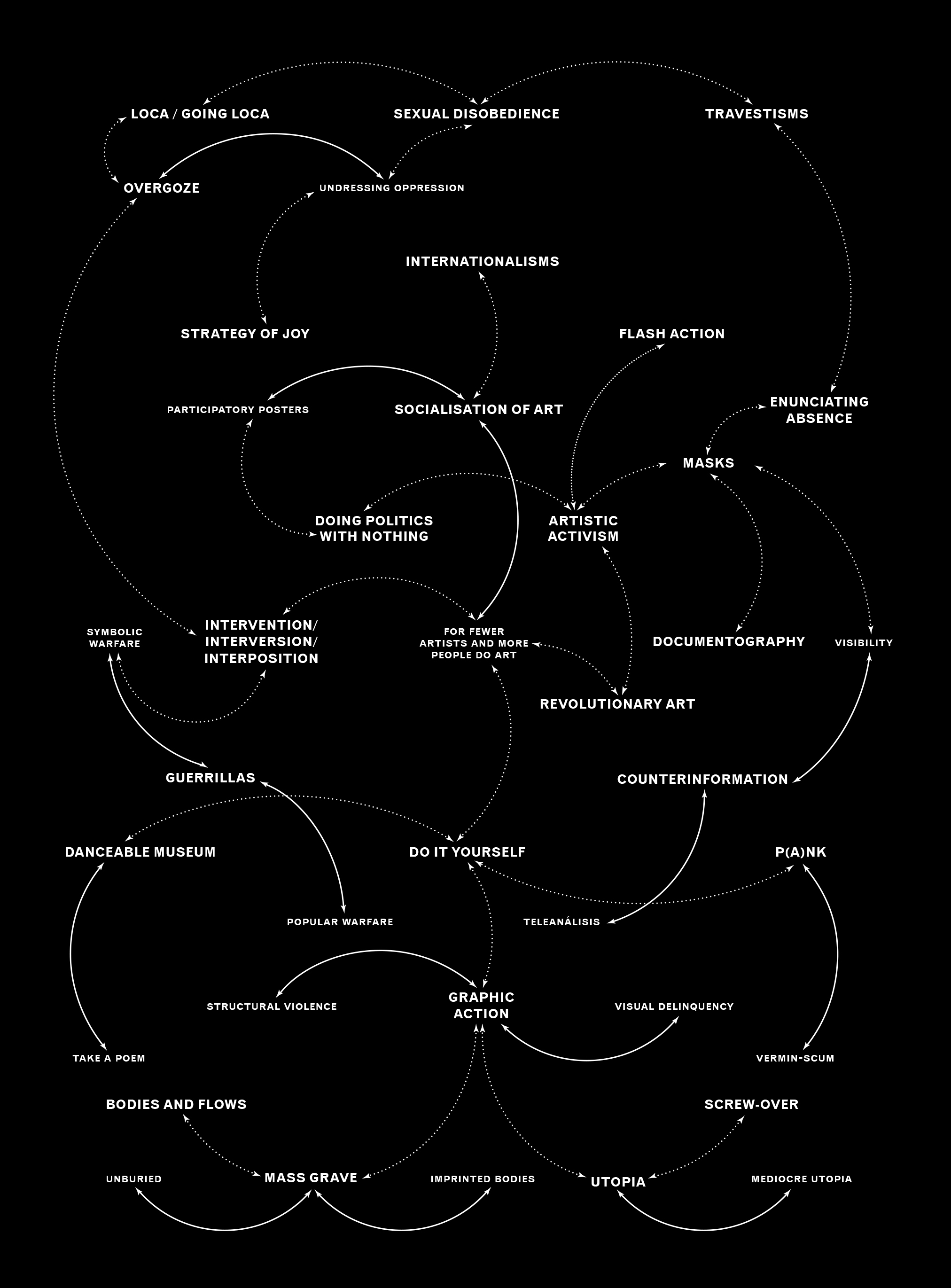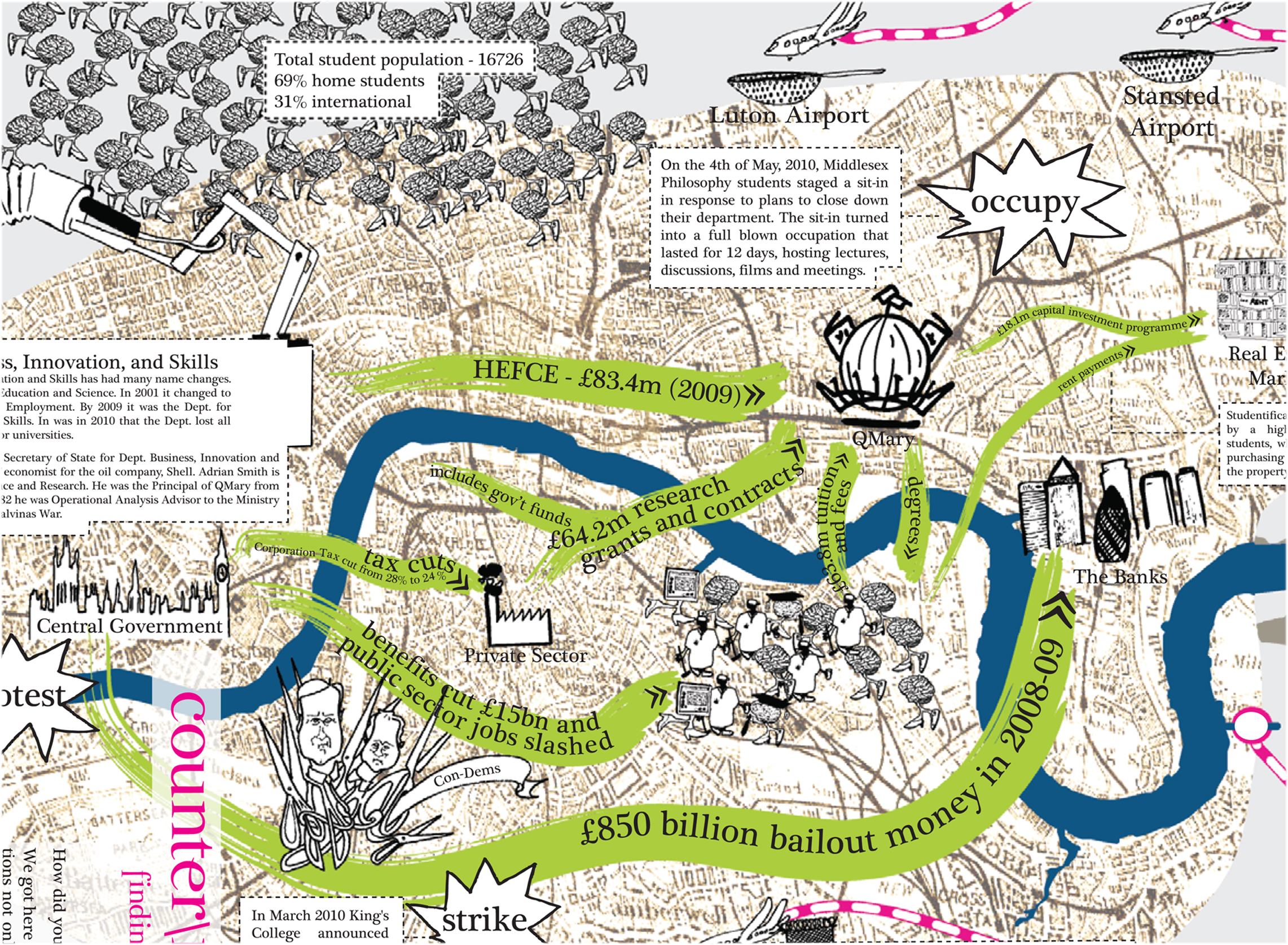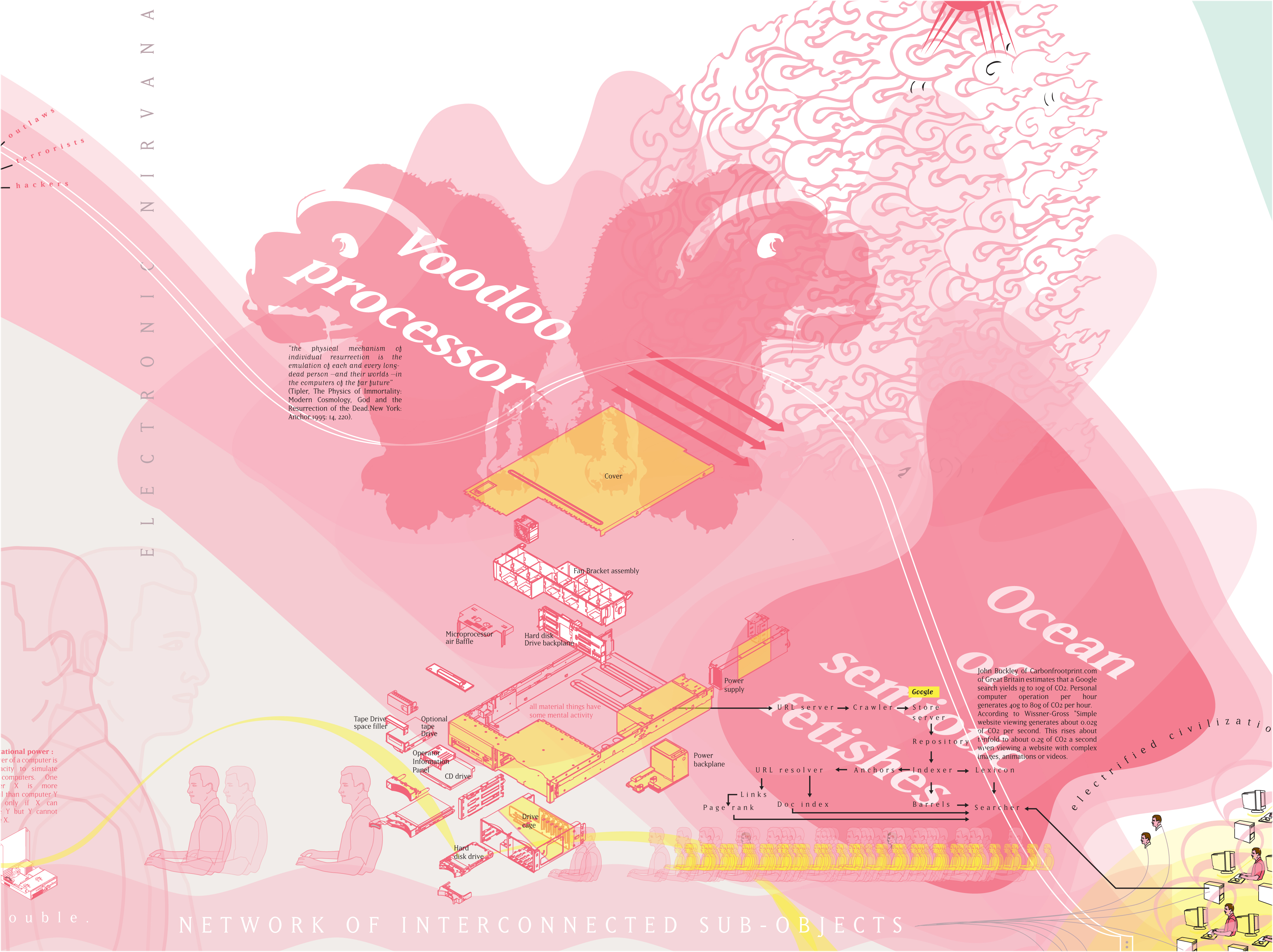Cartography as Research Process: A Visual Essay
Cristina Ribas
To cite this contribution:
Ribas, Cristina. ‘Cartography as Research Process: A Visual Essay.’ In response to Sohin Hwang and Pablo de Roulet, ‘Bibliography(chorème)=’ OAR Issue 1 (2017). OAR: The Oxford Artistic and Practice Based Research Platform Issue 1 (2017), http://www.oarplatform.com/cartography-research-process-visual-essay/.
Felix Guattari goes against the idea that scientific validity should undermine social functionality when he affirms that the academy is not the only site of theoretical research. He is interested in thinking from an ‘ethico-aesthetic paradigm,’ working upon the transversalisation of knowledge and practice by reframing the question of the institutions, and modes of subjectivation. The notion of subjectivation proposes to problematise the idea of the subject, thinking through the several collective and social forms that play out in our identity constructions. Through schizoanalytic cartographies and the ‘ethico-aesthetic paradigm,’1 Guattari devises transformative political effects that function within both subjectivity and reality. He describes schizoanalytic cartography as ‘a descriptive or functional cartography’; in the present essay, I follow Guattari’s definition, bringing it together with the work of Suely Rolnik on schizoanalytic cartographies.2 Guattari continues: ‘In my estimation, this would involve an invitation to all parties and groups concerned, in accordance with the appropriate modalities, to participate in the activity of creating models that touch on their lives.’3 Guattari proposes a very pragmatic task within cartography, one that works as a research tool and, at the same time, as a way of theorising and inviting action. In this visual essay, I respond to this approach by suggesting, in return, that mapping, diagramming, and devising cartographic procedures all engage several subjective, aesthetic and semiotic processes that constitute forms of research in and of themselves.
Here, the work of Ricardo Basbaum (Brazil),4 André Mesquita for Red Conceptualismos del Sur, the Queen Mary University Countermapping Project, the Iconoclasistas (Argentina), the Bureau D’Études (France), and the Beehive Collective (United States) are brought together. These are artists, collectives, or projects that use cartography as part of their research processes in singular ways. Some (such as Basbaum) apply cartography to their authorial artistic processes; for others (such as the Beehive Collective), cartography serves as a resource for collective mapping and for the collective production of knowledge, the formation of groups, and to further struggles for organisation and education. Schizoanalytic cartography as a practice of collective research – along with certain forms of militancy and activism – allows us to consider the production of visual cartographies, maps, or diagrams as techniques of subjectivation. Thus, cartography becomes a tool not only to plot realities and relations, but also to analyse and transduce signs, forces, and more. Cartography then works as a tool to consider the subjectivity of cartographer-researchers and to interfere in the dichotomy that separates researchers from the subject of their research. This further breaks apart the idea that the effects of research can be accomplished only once the research itself is ‘completed.’
In examining the work of these artists and groups, I see how Guattari’s definition of cartography encounters the practice and theory of ‘militant research.’5 From a schizoanalytic perspective, cartography operates as a militant process that devises analyses of the flows of power and capital and that, at the same time, works as a constitutive tool for the processes of subjectivation. Thus, it generates multiple processes of singularisation, resistance, and defense. This means that cartography produces ways of situating oneself (whether as an individual, a group, or a struggle), of mapping one’s surroundings, contradictions, and blockages, and also of mapping possibilities of escape or reinvention. Working from the context of schizoanalytic cartography, the Brazilian researcher Eduardo Passos further develops the notion of ‘technologies of subjectivation.’ Passos writes that we must evaluate which new theoretic-methodological devices can help us move forward in the task of producing concepts about subjectivity, and in the equally essential task of producing effects upon our shared reality6: in other words, upon the concreteness of the world. This approaches the definition given by the former Spanish collective Precarias a la Deriva, according to which ‘militant investigation interrogates, problematises and “pushes” the real through a series of concrete procedures.’7 It is possible to see that cartographic processes desire to produce cognitive, political, and subjective effects upon the process of research itself.
With this visual essay, I want to create an analysis of the work of these artists, projects, and groups by producing a thread that can function itself as a cartographic process. This cartographic thread speaks to the production of knowledge that emerges from practice.
Ricardo Basbaum, Diagrams from NPB Project, 1994-2010, digitally produced images, size varies, Images courtesy of the artist.



André Mesquita, Perder la forma humana. Concepts and Tools Diagram, 2013, images digitally produced, size varies, Images courtesy of the artist and researcher, and Red Conceptualismos del Sur.


Countermapping Queen Mary Project, Counter\mapping QMary: finding your way through borders and filters, 2010, map and game, digitally produced and freely reproduced images, printed version 66 x 96 cm, full image followed by two details, Images courtesy of the project.



Iconoclasistas, Pictogramación, 2015, digitally produced and freely reproduced images, size varies, Images courtesy of the artists.
![]()
![]()
![]()
The Beehive Design Collective, MesoAmerica Resiste, 2004, hand drawing, digitally produced and freely reproduced images, size varies. Produced in collaboration with people on the frontlines of resistance to a regional development plan then known as Plan Puebla Panama (PPP), Image courtesy of the artists.

Bureau D’Études, The Eight Sphere, 2010, digitally produced and freely reproduced images, size varies, produced with TJ Demos and Nottingham Contemporary, full image followed by two details, Images courtesy of the artists.



Image Key
Ricardo Basbaum, Diagrams from NBP Project, 1994–2010
Fluidity, surfaces of contact, fields of forces, blockages… Affects and effects are mapped out in Basbaum’s diagrams. Basbaum develops diagrams in his artistic production as a means of mapping the development of concepts. They are also reflexively devised to produce ‘diagrammatic’ effects in the viewer/reader. In other words, he seeks to develop diagrams that work upon the production of desire. The diagrams in his work can also recall the history of his long-term project NBP – New Bases for Personality. This project addresses the relations between self and other through various objects, installations, and performances. NBP plays with the several modelisations of contemporary subjectivity, often specifically within the contemporary art world. Find more here.
André Mesquita, Diagram for Red Conceptualismos del Sur in ‘Perder la Forma Humana,’ 2013
This diagram connects movements, groups, insurgencies, and concepts within the context of Latin American aesthetic production in the 1980s. Mesquita developed this diagram as part of the larger research carried out by participants of the Red Conceptualismos del Sur network, which was presented as an exhibition and in a book that serves as a glossary of concepts and groups. The Red Conceptualismos del Sur is a network of artists, art historians, and researchers who, through a platform for common thought and action, resituate the coordinates of a discursive debate about conceptual and political Latin American art. Find more here.
Countermapping Queen Mary Project, 2010
This project consisted in a local intervention and research process within Queen Mary University in London. The map and game created by the research group in collaboration with the 3Cs/Counter Cartographies Collective exposes unseen and un-systematised data present in the complex global economy of knowledge production today: exploitation, gender inequalities, the disparity of various fees, and more. Find more here.
Iconoclasistas, Pictogramación, 2015
Iconoclasistas encompasses a vast production of cartographies in different parts of Latin America and throughout the world. For years, they produced a large catalogue of open-source signs (‘pictogramas’) that they made available to anyone interested in creating their own cartographies. Iconoclasistas also published the Manual de Mapeo Colectivo, a manual for the making of cartographies. Find more here.
The Beehive Design Collective, MesoAmerica Resiste, 2004
This collective develops collaborative processes that conceive images based on complex global stories. Their work is based on a transduction of ‘word to image,’ in which cartographies are intended to be used for further investigative processes through educational and organisational efforts. Their cartographies are strictly visual and rich in information, thereby re-engaging with perception and reading from the angle of a generic visualisation of systems and diagrams more often based in written content.8 Find more here.
Bureau D’Études, The Eight Sphere, 2010
This work investigates power and subjection in the era of global digital communication. How do control, monitoring, software design, and the internet grow along with the construction of our subjectivities? How can we distinguish between an automated response and ‘authentic’ participation? Bureau D’Études produces compelling images that investigate how contemporary forms of production infiltrate our lives and subsume our desires as well as our capacities for imagination, feeling, and thinking. Namely, these images are devised to develop as research into ourselves. Find more here.
1. Felix Guattari, Chaosmosis: An Ethico-Aesthetic Paradigm (Bloomington: Indiana University Press, 1992).
2 Suely Rolnik, Cartografia Sentimental: Transformações Contemporâneas do Desejo (Porto Alegre: Sulina, Editora da UFRGS, 2011).
3. Felix Guattari, Anti-Oedipus Papers (New York: Semiotext(e), 2006), 173.
4. Ricardo Basbaum, ‘Processes of Transformation, Diagram as a Concept’ (MA Dissertation, Goldsmiths College, University of London, 1994).
5. Marta Malo de Molina, Common Notions, ‘Part 1: Workers-inquiry, Co-research, Consciousness-raising’ (2004), accessed October 10, 2013, http://eipcp.net/transversal/0406/malo/en.
6. Eduardo Passos, ‘Pensando a subjetividade com conceitos híbridos: a psicologia em interface com a filosofia e a biologia,’ in Políticas da cognição (Porto Alegre: Sulina, 2008), 72.
7. Precarias a La Deriva, A la deriva por los circuitos de la precariedad femenina (Madrid: Traficantes de Sueños, 2004), 92.
8. For a complete history of the creative process behind this image, see http://beehivecollective.org/graphics-projects/mesoamerica-resiste/.
